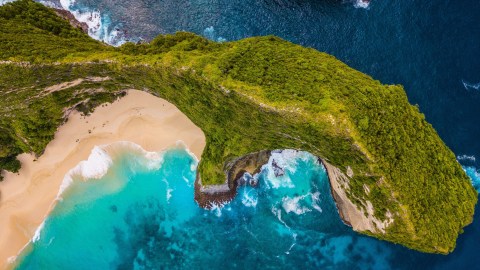Study: Much of the surface ocean will shift in color by end of 21st century

Jennifer Chu | MIT News Office
February 4, 2019
Climate change is causing significant changes to phytoplankton in the world’s oceans, and a new MIT study finds that over the coming decades these changes will affect the ocean’s color, intensifying its blue regions and its green ones. Satellites should detect these changes in hue, providing early warning of wide-scale changes to marine ecosystems.
Writing in Nature Communications, researchers report that they have developed a global model that simulates the growth and interaction of different species of phytoplankton, or algae, and how the mix of species in various locations will change as temperatures rise around the world. The researchers also simulated the way phytoplankton absorb and reflect light, and how the ocean’s color changes as global warming affects the makeup of phytoplankton communities.
The researchers ran the model through the end of the 21st century and found that, by the year 2100, more than 50 percent of the world’s oceans will shift in color, due to climate change.
The study suggests that blue regions, such as the subtropics, will become even more blue, reflecting even less phytoplankton — and life in general — in those waters, compared with today. Some regions that are greener today, such as near the poles, may turn even deeper green, as warmer temperatures brew up larger blooms of more diverse phytoplankton.
“The model suggests the changes won’t appear huge to the naked eye, and the ocean will still look like it has blue regions in the subtropics and greener regions near the equator and poles,” says lead author Stephanie Dutkiewicz, a principal research scientist at MIT’s Department of Earth, Atmospheric, and Planetary Sciences and the Joint Program on the Science and Policy of Global Change. “That basic pattern will still be there. But it’ll be enough different that it will affect the rest of the food web that phytoplankton supports.”
Dutkiewicz’s co-authors include Oliver Jahn of MIT, Anna Hickman of the University of Southhampton, Stephanie Henson of the National Oceanography Centre Southampton, Claudie Beaulieu of the University of California at Santa Cruz, and Erwan Monier, former principal research scientist at the MIT Center for Global Change Science, and currently assistant professor at the University of California at Davis, in the Department of Land, Air and Water Resources.
Chlorophyll count
The ocean’s color depends on how sunlight interacts with whatever is in the water. Water molecules alone absorb almost all sunlight except for the blue part of the spectrum, which is reflected back out. Hence, relatively barren open-ocean regions appear as deep blue from space. If there are any organisms in the ocean, they can absorb and reflect different wavelengths of light, depending on their individual properties.
Phytoplankton, for instance, contain chlorophyll, a pigment which absorbs mostly in the blue portions of sunlight to produce carbon for photosynthesis, and less in the green portions. As a result, more green light is reflected back out of the ocean, giving algae-rich regions a greenish hue.
Since the late 1990s, satellites have taken continuous measurements of the ocean’s color. Scientists have used these measurements to derive the amount of chlorophyll, and by extension, phytoplankton, in a given ocean region. But Dutkiewicz says chlorophyll doesn’t necessarily have reflect the sensitive signal of climate change. Any significant swings in chlorophyll could very well be due to global warming, but they could also be due to “natural variability” — normal, periodic upticks in chlorophyll due to natural, weather-related phenomena.
“An El Niño or La Niña event will throw up a very large change in chlorophyll because it’s changing the amount of nutrients that are coming into the system,” Dutkiewicz says. “Because of these big, natural changes that happen every few years, it’s hard to see if things are changing due to climate change, if you’re just looking at chlorophyll.”
Modeling ocean light
Instead of looking to derived estimates of chlorophyll, the team wondered whether they could see a clear signal of climate change’s effect on phytoplankton by looking at satellite measurements of reflected light alone.
The group tweaked a computer model that it has used in the past to predict phytoplankton changes with rising temperatures and ocean acidification. This model takes information about phytoplankton, such as what they consume and how they grow, and incorporates this information into a physical model that simulates the ocean’s currents and mixing.
This time around, the researchers added a new element to the model, that has not been included in other ocean modeling techniques: the ability to estimate the specific wavelengths of light that are absorbed and reflected by the ocean, depending on the amount and type of organisms in a given region.
“Sunlight will come into the ocean, and anything that’s in the ocean will absorb it, like chlorophyll,” Dutkiewicz says. “Other things will absorb or scatter it, like something with a hard shell. So it’s a complicated process, how light is reflected back out of the ocean to give it its color.”
When the group compared results of their model to actual measurements of reflected light that satellites had taken in the past, they found the two agreed well enough that the model could be used to predict the ocean’s color as environmental conditions change in the future.
“The nice thing about this model is, we can use it as a laboratory, a place where we can experiment, to see how our planet is going to change,” Dutkiewicz says.
A signal in blues and greens
As the researchers cranked up global temperatures in the model, by up to 3 degrees Celsius by 2100 — what most scientists predict will occur under a business-as-usual scenario of relatively no action to reduce greenhouse gases — they found that wavelengths of light in the blue/green waveband responded the fastest.
What’s more, Dutkiewicz observed that this blue/green waveband showed a very clear signal, or shift, due specifically to climate change, taking place much earlier than what scientists have previously found when they looked to chlorophyll, which they projected would exhibit a climate-driven change by 2055.
“Chlorophyll is changing, but you can’t really see it because of its incredible natural variability,” Dutkiewicz says. “But you can see a significant, climate-related shift in some of these wavebands, in the signal being sent out to the satellites. So that’s where we should be looking in satellite measurements, for a real signal of change.”
According to their model, climate change is already changing the makeup of phytoplankton, and by extension, the color of the oceans. By the end of the century, our blue planet may look visibly altered.
“There will be a noticeable difference in the color of 50 percent of the ocean by the end of the 21st century,” Dutkiewicz says. “It could be potentially quite serious. Different types of phytoplankton absorb light differently, and if climate change shifts one community of phytoplankton to another, that will also change the types of food webs they can support. “
This research was supported, in part, by NASA and the Department of Energy.
—
Reprinted with permission of MIT News





